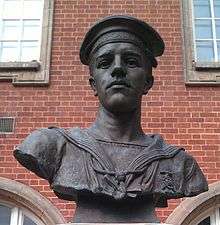John Henry Carless
| John Henry Carless | |
|---|---|
 John Henry Carless | |
| Born |
11 November 1896 Walsall, England |
| Died |
17 November 1917 (aged 21) Heligoland, Germany |
| Allegiance |
|
| Service/branch |
|
| Years of service | 1914-1917 † |
| Rank | Ordinary Seaman |
| Unit | H.M.S. Caledon |
| Battles/wars | World War I |
| Awards | Victoria Cross |
John Henry Carless VC (11 November 1896 – 17 November 1917) was a British recipient of the Victoria Cross during the First World War.
VC
Carless was born in 1896 to John Thomas and Elizabeth Carless, of 31 Tasker Street, Walsall, Staffordshire (now in the West Midlands).[1] He died when he was 21 years old, and an Ordinary Seaman in the Royal Navy during World War I. He was awarded the Victoria Cross for his gallant actions on 17 November 1917 aboard HMS Caledon at the Second Battle of Heligoland Bight, Germany, which led to his death.
In mid-November 1917 British ships battled German forces in the Second Battle of Heligoland Bight (off Germany's north coast). During the action Seaman Carless took a terrible shrapnel wound to the stomach but kept loading his gun, and encouraged his colleagues to do likewise. Once relieved, he collapsed and died. He was buried at sea the following day.
In June 1918, Carless' parents received his posthumous VC from King George V.
Citation
For most conspicuous bravery and devotion to duty. Although mortally wounded in the abdomen, he still went on serving the gun at which he was acting as rammer, lifting a projectile and helping to clear away the other casualties. He collapsed once, but got up, tried again, and cheered on the new gun's crew. He then fell and died. He not only set a very inspiring and memorable example, but he also, whilst mortally wounded, continued to do effective work against the King's enemies.
Carless is listed on Panel 25 of the Portsmouth Naval Memorial.[1]
Walsall Museum

The Walsall public raised money for the erection of a memorial. A bronze bust was created by Wolverhampton-based Robert Jackson Emerson (1878–1944) mounted on a large plinth of Portland stone, outside Walsall Museum (at 52°35′09″N 1°58′45″W / 52.585906°N 1.979087°W), Lichfield Street. On 20 February 1920 it was unveiled by Admiral Sir Walter Cowan, whose flagship had been HMS Caledon, and the ship's white ensign was presented to Walsall's mayor at the time.
The museum has a display on Carless, including a replica of his VC (the original, bequeathed to the people of Walsall in 1986, is held in store, for security reasons), the ship's name-band from his uniform cap, and an oil portrait, commissioned by the Walsall Services Memorial Club.
Memorials
In December 2009, a memorial plaque to Carless and two other recipients of the Victoria Cross, James Thompson and Charles George Bonner, was unveiled at Walsall Town Hall, Leicester Street.[3] Three thoroughfares in Walsall commemorate John Carless’ bravery - Carless Street,[4] in Caldmore, not far from where he was born, along with Caledon Street[5] and Caledon Place in Pleck. A blue plaque on Carless Street notes the origins of the street's name.[6]
References
- 1 2 Carless, John Henry, Commonwealth War Graves Commission
- ↑ The London Gazette: (Supplement) no. 30687. p. 5857. 14 May 1918. Retrieved 30 April 2015.
- ↑ Lloyd, Matt (30 December 2009). "Black Country Victoria Cross winners are honoured". Birmingham Mail. Retrieved 31 December 2009.
- ↑ 52°34′37″N 1°58′49″W / 52.57684°N 1.98017°W
- ↑ 52°34′30″N 1°59′55″W / 52.57491°N 1.99871°W
- ↑ Plaque #30545 on Open Plaques.
- Monuments to Courage (David Harvey, 1999)
- The Register of the Victoria Cross (This England, 1997)
- VCs of the First World War - The Naval VCs (Stephen Snelling, 2002)
External links
| Wikimedia Commons has media related to John Henry Carless. |